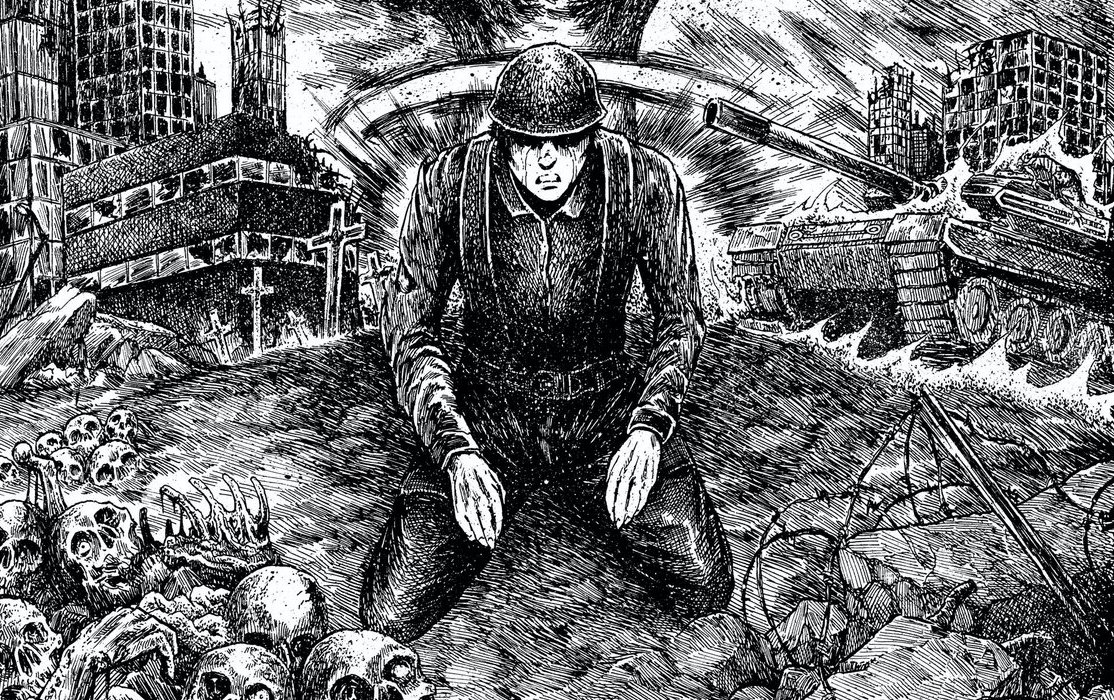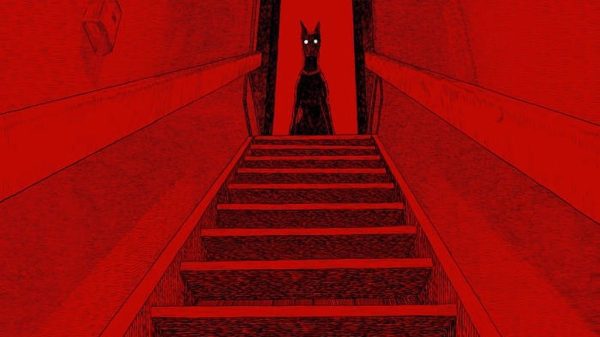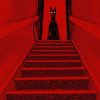Semantic satiation is a phenomenon that occurs when certain words or phrases are repeated so much that they lose their meaning. If there is one word that is overused to the point of meaninglessness in writing about heavy music, it is “brutal.” This word, unless it’s specifically being used to refer to the Brutal Death Metal subgenre, is bandied about in so many articles about metal bands that it essentially communicates nothing about the music in question. There are times, however, when “brutal” really is the only appropriate word for a band’s output, times when synonyms just won’t do.
Saintbreaker is brutal.
Even if no other band is making music that is brutal in the truest sense, this band is. In the songs on their eagerly awaited sophomore LP, Unrelenting Violence, the band deals not simply with the figurative brutality of the shredding riffs and pummeling blastbeat variety, but also with the very literal brutality of war, of orphaned children, of leveled cities, of extinct civilizations, and of the legacies of unapologetic imperialism that are still dictating world events today.
Having built a reputation on extraordinary musicianship, thoughtful songcraft, and unforgettable live performances, Saintbreaker has developed a devoted fanbase over their nearly ten years together, a fanbase who has been frothing for a new full-length for some time now.
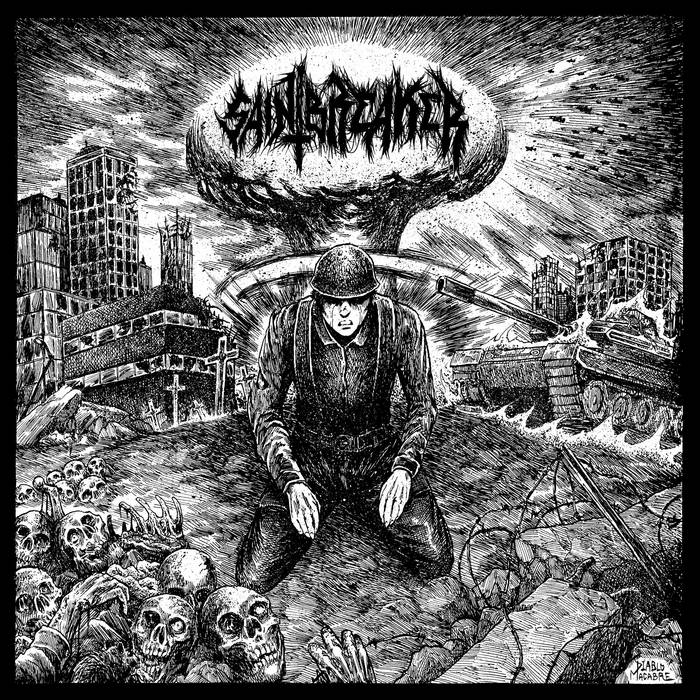
Most musicians have heard the advice at some point: “Don’t practice. Perform.” If it weren’t clear from their tireless live performance schedule, it would be clear from the precision and cohesion of their songs that the members of Saintbreaker have internalized this advice. Despite crafting songs that build on the art of generations of the most skill-oriented thrash and crossover bands, despite boasting riffs that would force the most prodigious players to dial the metronome back a few notches to keep up, the band is most impressive in how together they always are, in the studio and on the stage.
That lock-step exactitude and the Gatling cannon rapidity are part of what makes Saintbreaker’s sound so fitting for its themes of war, terror, fallout, and military savagery. Though the integration of the history of warfare into lyrical themes and imagery is well-established in the thrash genre, Saintbreaker approaches these topics with a knowledge, sincerity, and gravity that is all too rare, so instead of just using the tanks and helmets to give the impression of especially violent songcraft, the band laces its songs with centuries of the stratified dead. Especially literate in the adage that “war never changes,” Saintbreaker scavenges in the catacombs for lesser-known war stories, creating blistering soundscapes with fusillades of drums and semi-automatic string-slinging to sear the flesh along with the screams of those lost in trenches without water rations. An especially powerful track among a whole album of “best of 2023” songs is “Conflict Diamonds,” which draws uncomfortable parallels between the modern blood diamond trade and the all too easily ignored Belgian genocide of Congolese people for their rubber. Never shying away from the very darkest parts of humanity, and never treating them as simple fodder for chickenhawk fantasies, these “Desert Thrash Guerillas” are able to write serious music about serious trauma in a way that invites the listener to channel a vengeful rage on behalf of the unjustly slain, and to prepare for a war in the streets to prevent it from happening again.
While Saintbreaker has always been an essential band in modern crossover and thrash, their long-awaited sophomore LP, Unrelenting Violence, brings fans a band that is more confident and more masterful than ever, with a new infusion of death and grind that enhances their already overwhelming firepower.
If you’ve seen them perform, Saintbreaker is already one of your favorite bands. If you haven’t, Unrelenting Violence is all the convincing you need.

Saintbreaker vocalist Nick Schellbach talked to Cvlt Nation about the release.
The last time Cvlt Nation covered Saintbreaker was your amazing quarantine performance. What has Saintbreaker been up to since 2020?
In the time since then, we finished recording our second full-length album Unrelenting Violence, and we are also currently writing new songs for a follow-up release we hope to release later this year or early 2024. Apart from that, we’ve just been enjoying being able to play live shows again since the lockdown ended. We definitely missed playing and going to shows during that period.
Can you describe the band’s development since the 2017 debut LP, Beaten Into Belief?
I think we consciously just wanted to progress naturally in a way a lot of bands like us do. We wanted our next release to be heavier, have better songwriting, be faster, tighter, et cetera, et cetera; we would just try to find new ways to outdo ourselves compared to the last time. Especially during the lockdown, we had nothing really to distract us from being able to focus on writing these new songs, and I think the amount of care we took really shows.
Saintbreaker seems to have an endless energy for performing and touring. What role does playing live have in who the band is? What role has playing live had in developing the songs on Unrelenting Violence?
I don’t know about endless but we definitely try our best to hustle our music and art as best we can. We’re still very much an underground DIY sort of band, so it’s a lot of work along with plenty of trial and error, but there’s still nothing that makes us happier than seeing a bunch of music fans go absolutely nuts when we play. So yeah, our music is definitely geared more toward that live audience than trying to sound pretty on some mainstream rock radio. For this album, we definitely had that mentality at the forefront of our minds when we were jamming and writing. I’d say this new album is very mosh-heavy, the way our long-time fans know and love it!
The 2020 deaths of Wade Allison and Riley Gale brought extra attention to thrash and crossover in the metal and even mainstream musical worlds. Has Saintbreaker seen a shift in their audiences since that time?
First off, Rest In Power to both of them! Power Trip, in my humble opinion, is probably the best thrash band in recent years to hit it big-time in the metal world. And Iron Age? If you’ve never heard of them, go listen to them now! Essentially, Iron Age walked so Power Trip could run.
As far as audiences go, there’s definitely been a lot more new faces from this new younger generation of music fans post-2020. It definitely feels like the lockdown made people anxious for shows again and naturally even more so for the young people who are probably just beginning to explore more heavy and extreme music for the first time.
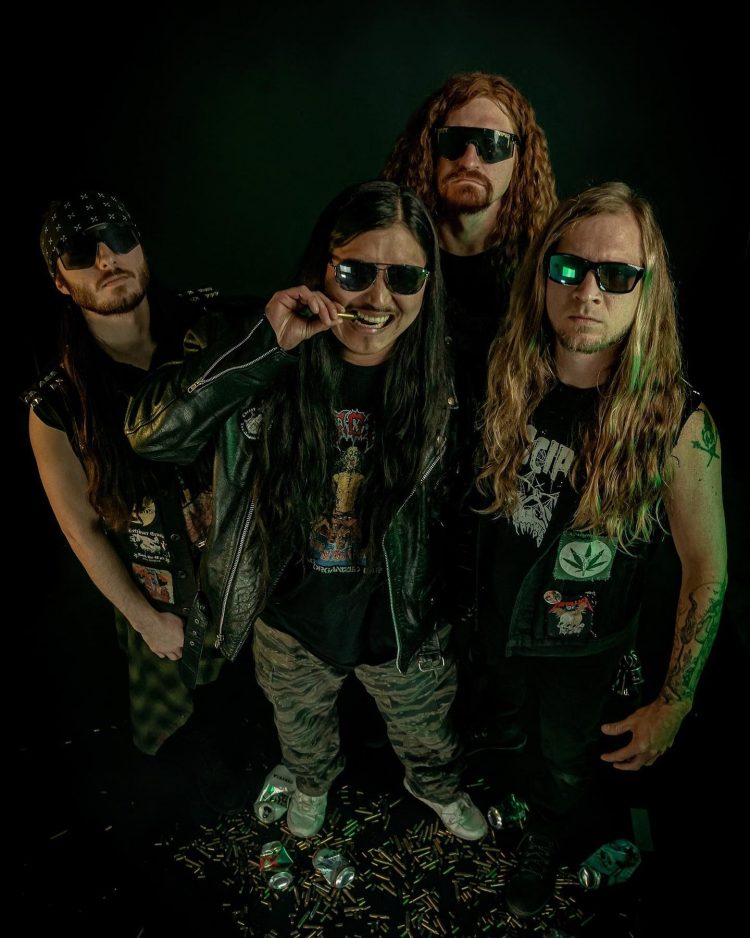
What were some of the major musical influences for this album? Can you describe the writing process?
Oh boy, where to begin? The band’s foundation is definitely rooted in thrash, but we also draw a lot of inspiration from death metal, grindcore, hardcore punk, d-beat, power violence, and crust punk. I think we definitely doubled down on more of the thrash and death metal influences for this release. But all in all, it’s a pretty good mixture of all of our influences. There are songs that have more S.O.D. and Cryptic Slaughter vibes. Some songs are more Razor- and Exodus-sounding. Others lean more towards Terrorizer, Dark Angel (RIP Jim Durkin), classic Sepultura, or Slayer. Sprinkle in a little Ringworm and Napalm Death for good measure and some Demolition Hammer or Kreator maybe? It’s definitely a mutt-like mixture of bands we love and there are plenty more influences than the ones I just named.
And as far as the writing process goes, there’s nothing really too fancy. Generally, one of us has a musical idea that we jam on and try to build a song around it piece by piece. I will say that having such a diversity and open-mindedness towards our musical influences can mean we sometimes take longer to finish writing compared to other bands. But at the end of the day, we all have to be creatively satisfied and happy with how the songs come out, so it’s worth it in the end from an artistic standpoint.
History and especially military history have long been a focus of thrash bands, more so than bands in other subgenres. What is it about thrash that pairs so well with military history? Can you describe Saintbreaker’s relationship to the history of war, especially lesser-known aspects of it?
For better or worse, heavy metal is a genre that thrives off of dark and edgy imagery. Thrash is a metal subgenre that is known for its speed and aggression, especially compared to the metal bands that came before them. But I also tend to think people undersell the influence that punk and hardcore had on thrash back then. To me, it makes sense some of those bands would ditch the fantasy lyrics in favor of stuff more like Discharge and Dead Kennedys.
As far as the band is concerned, I can only really speak for myself when it comes to this topic, as the other guys pretty much leave it all to me to write all of the lyrical content for the band. But I would say I’ve always had a morbid fascination with war since I was a kid. I grew up going to Blockbuster with my parents and renting old classic WWII films to watch. Stuff like The Great Escape, A Bridge Too Far, Midway, and so on. That and early computer games like Battlefield 1942 are what I would say kickstarted my interest and passion for history. And given that our style of thrash definitely leans more towards the brutal side of the spectrum for this genre, it felt like a natural thing to blend my fascination with the darker aspects of history with my love for extreme music.
For this album, I definitely nerded out a bit more for some of the song lyrics. For example, the lyrics for the song “Free Fire Zone” makes reference to the reconcentrado-style concentration camps the United States used against the Filipinos during the Philippine-American War of 1899 to 1902. The song “Zachistka” is a song written from the perspective of both a Russian Soviet soldier fighting in Afghanistan in the 1980s and a member of the mujahideen fighting against the Soviets in the same war. Stuff like this that’s not so well known but is still important to learn about because of how it shaped the world of today and ultimately our future as well. At least, that’s how I personally feel about it.
Can you describe the heavy music scene in Arizona? Who are some bands that more people should be listening to?
Lots of cool bands. Especially new younger bands, which is awesome! Some to check out would definitely be Misanthropic, Nuclear Remains, Kthulu, Eternal, Carpet Bomb, Blood Loss, and Grail. As far as more established AZ bands go, I obviously have my personal biases but I would say people should jam more Ceremented, Thra, Sex Prisoner, Magnum Force, Sorrower, Gestation, Aftermath, Groin, Get A Grip, Savage Necromancy, The Executed, Pig City, Goya, Six Million Dead, Skullcrush, and Scattered Guts (our drummer’s other band). There are so many other cool AZ bands I could list but then this list would drag on for way too long.
What do you love about metal generally and thrash/crossover specifically right now? What should change?
I would say musically metal is in a very good place right now. I grew up during the heyday of what my generation’s version of glam metal was in the form of bands like Asking Alexandria and Attack Attack! being marketed as metal music. So seeing bands like Gatecreeper, Frozen Soul, Power Trip, Enforced, and others hit it big-time feels like a breath of fresh air compared to back then. There have always been sick underground bands but especially with the internet age, metal music has become more accessible than ever. Some people might think that sucks, but I would say, the more, the merrier.
Slowly, we’re also seeing more crossover between hardcore and metal scenes these days as well, which is cool. I’m definitely more of a metal dude who happens to love lots of punk and hardcore. Metal, punk, and hardcore tend to stick to their own lanes, for the most part, these days (from what I’ve observed) but gradually I think we’re going to see more barriers and gatekeeping between scenes go away over time. At least, I hope so. I could totally be wrong about this. More scene solidarity! To quote Infest: “WHERE’S THE UNITY?!” At least the different scenes don’t actively beef with each other from what I hear how it was back in the 1980s. Only time will tell on that one in the end.
What should people know about Saintbreaker? About Unrelenting Violence?
Is there anything else you’d like to say?
Honestly, this band has done more than I ever expected it to do. The fact that we’ve managed to stick around for almost ten years now and our fans still share the same excitement we have for writing and playing metal music is nothing short of amazing. We’ve gotten to play with bands I never imagined we’d ever be able to play with. And while it’s been a decent wait for us to finally be able to put out our next full-length release, we’re super stoked to have everyone jam these new songs. We can proudly say that this is our best quality release we’ve put out as a band. So if you prefer your thrash riffs ugly and brutal over flashy and sexy, be sure to pick up a copy and come out to one of our shows if we happen to roll through your town. Other than that, be excellent to each other and party on! Peace!
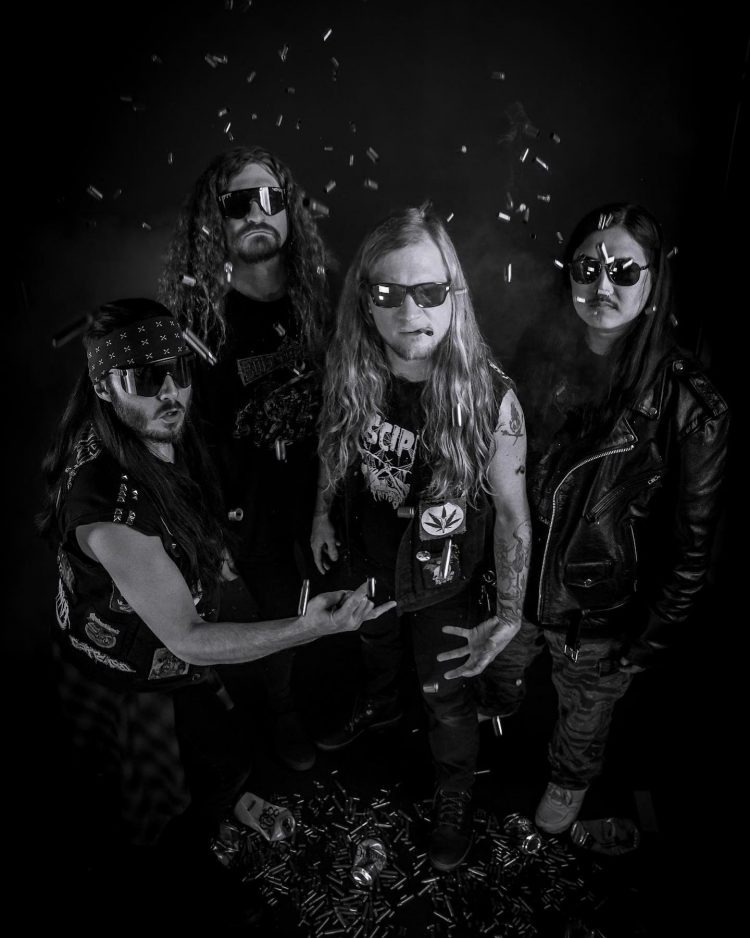
Unrelenting Violence was recorded at Villain Recording with Byron Filson.
The art is by Diego Garza.
Photos by Bearded Gonzo Photography.

